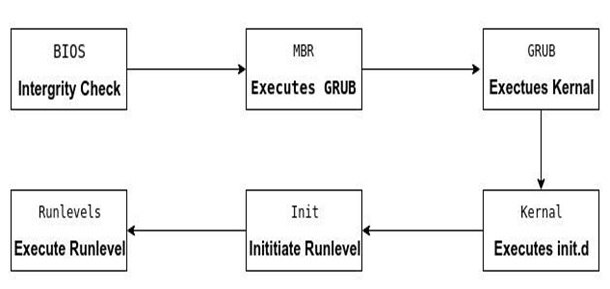操作系统的引导过程_引导过程-操作系统

操作系统的引导过程_引导过程 操作系统
操作系统的引导过程
启动过程 ( Booting process )
When our computer is switched on, It can be started by hardware such as a button press, or by software command, a computer’s central processing unit (CPU) has no software in its main memory, there is some process which must load software into main memory before it can be executed.
当我们的计算机打开电源时,可以通过按按钮之类的硬件来启动它,也可以通过软件命令来启动它,而计算机的中央处理器(CPU)的主内存中没有软件,必须执行某些过程才能将软件加载到主存储器中。内存,然后才能执行。
After the computer is turned on, a specific program needs to load in the computer’s main memory which is Operating System.
打开计算机电源后,需要在计算机的主内存(操作系统)中加载特定程序。
In the Booting process , System will check all the hardware’s and Software’s those are installed or attached with the system and all the Files those are required for running a system, also loads into memory.
在 引导过程中 ,系统将检查与系统一起安装或连接的所有硬件和软件,以及运行系统所需的所有文件,并将这些文件也加载到内存中。
ROM also reads the information stored in these files.
ROM还读取存储在这些文件中的信息。
At the Time of Booting all Instructions will be read required to start the system.
引导 时,将阅读启动系统所需的所有说明。
OS holds the following processes at the time of booting :
操作系统在 引导 时会保留以下进程:

引导过程的类别 ( Categories of Booting Process )
There are two categories of Booting process ,
引导过程分为两类 ,
Hard (Cold) Booting
硬(冷)启动
Soft (Warm) Booing
软(暖)响
1)硬(冷)启动 ( 1) Hard (Cold) Booting )
Restart a computer is referred to as rebooting, It can be “hard” or “cold”, e.g. after power to the CPU is switched from off to on. In this category of booting the computer starts from a completely dead state.
重新启动计算机称为“重新启动”。它可以是“硬”或“冷”的,例如,在将CPU的电源从关闭切换为打开之后。 在此类 启动中 ,计算机从完全死机状态启动。
For instance, When we press the Power Button, the system starts with its initial state. It reads all the information that is stored in the Read-Only Memory (ROM) and automatically the Operating System will be loaded into the system’s main memory.
例如,当我们按下电源按钮时,系统以其初始状态启动。 它读取存储在只读存储器(ROM)中的所有信息,并且操作系统将自动加载到系统的主存储器中。
2)软(暖)沸腾 ( 2) Soft (Warm) Booing )
In “soft” or “warm” booting , the power is not cut. In some systems, a soft boot may optionally clear RAM to zero.
在“软”或“热” 启动中 ,电源不被切断。 在某些系统中,软启动可以选择将RAM清除为零。
POST(开机自检) ( POST (Power On Self Test) )
The Power On Self Test happens each time after turn on your computer.
每次打开计算机后都会进行开机自检。
It is a diagnostic testing sequence for all the hardware devices. It checks hardware device availability. It sends a signal to all the hardware devices and they send an acknowledgment back to it. If an acknowledgment is sent by that device then that device is working, if not then it will be removed from the system.
这是对所有硬件设备的诊断测试序列。 它检查硬件设备的可用性。 它向所有硬件设备发送信号,然后它们将确认发送回去。 如果该设备发送了确认,则该设备正在运行;否则,它将从系统中删除。
If there is any error then a beep like sound generates or some error messages displays on the monitor. These beeps are referred to as POST beep codes.
如果有任何错误,监视器上会发出类似声音的哔哔声或一些错误消息。 这些蜂鸣声称为POST蜂鸣声代码。
主引导记录 ( Master Boot Record )
The Master Boot Record (MBR) is the information which is in the first sector of any hard disk that indicates how and where an operating system is located so that it can be boot (loaded) into the computer’s main memory or random access memory.
主引导记录(MBR)是任何硬盘的第一扇区中的信息,它指示操作系统的放置方式和位置,以便可以将其引导(加载)到计算机的主内存或随机存取存储器中。
The MBR is also sometimes referred to as the “partition sector” or the “master partition table”. It has only four primary partitions. We can create more partitions by setting the fourth partition as the extended partition and also we can create sub-partitions (or logical drives) within it.
MBR有时也称为“分区扇区”或“主分区表”。 它只有四个主分区。 我们可以通过将第四个分区设置为扩展分区来创建更多分区,也可以在其中创建子分区(或逻辑驱动器)。
It holds information about GRUB (or LILO in old systems).
它包含有关GRUB(或旧系统中的LILO)的信息。
Its size is less than 512 bytes. It has three components
它的大小小于512字节。 它包含三个组成部分
- primary boot loader information in 1st 446 bytes.
- partition table information in next 64 bytes.
- MBR validation checks in the last 2 bytes.
在里面 ( init )
This is the last step of the booting process . It decides the run level by looking at the / etc / inittab file.
这是 引导过程 的最后一步。 它通过查看/ etc / inittab文件来确定运行级别。
The initial state of the operating system decides by the run level.
操作系统的初始状态由运行级别决定。
Following are the run levels of Operating System:
以下是操作系统的运行级别:
Level
水平
0 - System Halt
0-系统停止
1 - Single user mode
1-单用户模式
2 - Multiuser, without NFS
2-多用户,无NFS
3 - full multiuser mode
3-完整的多用户模式
4 - unused
4-未使用
5 - Full multiuser mode with network and X display manager(X11)
5-具有网络和X显示管理器(X11)的完全多用户模式
6 - Reboot
6-重新启动
We would set the default run level to either 3 or 5.
我们将默认运行级别设置为3或5。
We can execute ‘grep initdefault / etc/ inittab’ on your system to identify the default run level.
我们可以在您的系统上执行 ‘grep initdefault / etc / inittab’ 来识别默认运行级别。
Init uses run levels to load all appropriate program.
Init使用运行级别加载所有适当的程序。
The step after is to start up various daemons that support networking and other services. X server daemon manages display, keyboard, and mouse. You can see a Graphical Interface and a login screen is displayed during X server daemon is started.
接下来的步骤是启动支持网络和其他服务的各种守护程序。 X服务器守护程序管理显示,键盘和鼠标。 您可以看到图形界面,并且在X服务器守护程序启动期间显示登录屏幕。
引导期间失败 ( Failure during boot )
If the computer cannot boot, we will get a boot failure error. This error indicates that the computer is not passing POST or a device in the computer, such as the hard drive or memory, has failed.
如果计算机无法启动,我们将收到启动失败错误。 此错误表明计算机未通过POST,或者计算机中的设备(例如硬盘驱动器或内存)出现故障。
You may also hear a beep code to identify which hardware is failing during the POST.
您可能还会听到哔声代码,以标识POST期间哪些硬件发生故障。
An error message or blue screen may show on the screen as operating system files cannot be loaded, due to not being found or being corrupt.
屏幕上可能会显示错误消息或蓝屏,这是由于找不到或损坏了操作系统文件而导致无法加载操作系统文件。
翻译自:
操作系统的引导过程